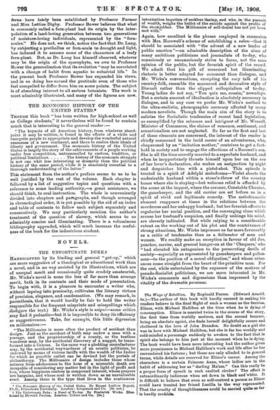THE ORIGIN OF LAND PLANTS.*
THIS work, by the Professor of Botany in Glasgow University, is too technical for detailed notice in our pages, but it is such a remarkable contribution to botanical literature that we cannot omit a short reference to it. The book is mainly con- cerned with theories as to the origin of the leafy fern-plant and of the moss-fruit. It seems that certain algae represent in their general characters the source from which the land flora sprang. Since Hofmeister's classic researches it has been clear that the life cycle of a moss or fern consists of two alternating generations. The first phase is represented by the leafy moss-plant, and by the scale or tballus from which young ferns grow ; it is the one which bears sexual organs, and is known as the "gametophyte." The second phase is represented by the moss-fruit and the leafy fern- plant, and is neutral or sexless. This second phase is organically distinct from the first, and is known as the " sporo- phyte." Nothing strictly comparable to the sporophyte is known among the lower plants, and two views have been held concerning its origin. Some have regarded it as a structure gradually interpolated between successive generations resembling the first or sexual phase. Others have regarded it as a second generation, representing a metamorphosed individual originally similar to the first phase. Professor Bower is an ardent supporter of the former theory, which is now widely, though not universally, accepted for mosses ; but botanists appear to be equally divided between the two opinions as to the origin of the leafy fern-plant. Some very interesting facts with regard to a number of abnormal • Tha Origin of a Land Flom By F. 0. Bower, BoD., F.E.B. London: Macmillan and Co. [184.] ferns-. have lately been established by Professor Farmer and Miss Lattice Digby. Professor Bower believes that what is commonly called a fern-plant had its origin by the inter- polation of a land-loving generation between two generations rof moisture-loving individuals, represented by the "fern- scales." He does not, we think, notice the fact that Dr. Lang, by subjecting a prothallus or fern-scale to drought and light, has induced it to assume some of the characters of a leafy fern-plait. But, as Dr. Lang has himself observed, whatever may be the origin of the sporopbyte, we owe to Professor Bower the generalisation that its evolution "may be correlated -with a change of habit from aquatic. to subaerial life." In the present book Professor Bower has expanded his views, and in so doing has earned the gratitude even of those who -feel compelled to differ from him on some points. The subject is of absorbing interest to all serious botanists. The work is most admirably illustrated, and many of the figures are new.















































 Previous page
Previous page